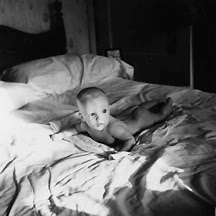 |
| PRODIGY: The artist at four months |
A Burgeoning Film Career Based on Random Encounters (New York Times, February 24, 2011).... Everything Ms. Nakadate has done during her decade-long career is discomfiting, and willfully so. Some will call her a narcissist, an opinion not dispelled by a display of 365 large color photographs of herself crying — one for every day of 2010 — in most cases stripped down to her underwear or less.
…..Rather than brush off the attention of unknown men, [Nakadate] would engage with some of the least appealing specimens: balding, overweight, badly dressed, pathetic solitaries in their 40s, 50s and 60s. In response to their advances, she would propose to go home with them if they would collaborate with her in making an art video. (more)
The Serial Sleepover Artist (New York Times, April 13, 2011) ....Ms. Robinson imagined a 13-week-long performance-art piece, and offered herself up as a guest (10 hours of housework included, but the host must supply the toothpaste) to anyone who would have her. (more)
I was planning to keep it secret for at least another few years, but after Keith Richards stole my title for his autobiography (that’s the last time I confide in him!) and I read about Laurel Nakadate and Kenya Robinson in the Times, I realized I had to reveal my project to the world. Everyone should know that I was there first.
So, yes, it’s called Life, and when completed, will be the longest performance art piece ever executed, as it started with my birth and will end when I’m eighty or ninety and choose to leave this body. I actually hit on the concept before I was born, since hanging out in the womb for nine months gave me a lot of time to think. The idea was to explore issues of gender, sexual identity, race, economic status, suburban ennui and the malleability of language in an extreme situation: the actual world. Luckily my father was a good amateur photographer, which meant that the first three years of my life were well documented in daily snapshots for which I often posed nude, topless, and sometimes crying. However I never felt that suffering was necessary for my work to be important. Rather I thought it would be even more challenging (but perhaps less acceptable to the art world, which associates grimness with significance) if I insisted on meeting each event that came my way with a cheerful attitude. I mean as long as I’m going to all this trouble, I might as well have fun.
And fun it has been, especially the part that anticipated Nakadate and Robinson’s work with strangers. Funded by odd jobs and fueled by alcohol and various well-chosen drugs, that segment of my practice took place over not months but years when, in the late seventies and early eighties, I regularly invited random people into my home or went to theirs, following late nights at Max’s Kansas City or Danceteria. Inventing what eventually became known as scatter art, I kept mementos of these encounters—single socks, not-so-white tighty whities, condom wrappers, ripped fishnet stockings and cassette tapes by the Fleshtones and the Weather Girls—stuffed into plastic garbage bags that would occasionally burst open, leaving their contents in piles on the floor.
The endurance aspect of my work has spanned decades, starting with having to sing “Old MacDonald” in nursery school, sitting next to Jimmy Earle as he picked his nose in Miss Reese’s fifth grade, and myriad temp jobs as a Kelly Girl (Marina Abramovic should try spending eight hours a day in the basement office of the Purchasing Manager at Evanston Hospital). Currently I've been focusing on phone encounters with customer service, notably the automated voice prompts utilized by Apple and Verizon, where I have made the significant discovery that yelling “fuck” loudly into the receiver gets me routed immediately to a live representative.
Although conceived of as a single performance, as I have grown and changed, so has my work. Influenced by the writings of Derrida and Foucault, my thinking has become increasingly post-structuralist so that now, not wanting to be confined to a single theme, I'm choosing to thrust myself directly into the environment where, unfettered by artificial manipulation or even expectation, I simply allow my work to unfold. This decision has its roots not only in philosophy but practicality, because if there's one thing I've learned from doing this, it's that no matter how much I plan, shit happens.







